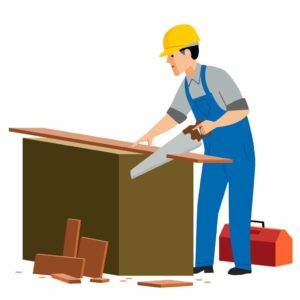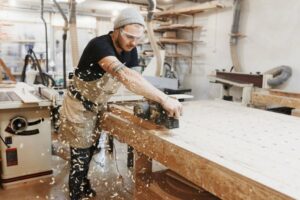Hey, I am James Brown, and welcome to my new article, where I will tell you the top 13 woodworking tips everyone should follow.
Woodworking can be a wonderful pastime or career, but safety must always come first. Without sufficient safeguards, woodworking can be risky and cause significant damage. To ensure a safe woodworking experience, educate yourself and follow safety requirements.
Learn about safety measures for woodworking in this post. Precautions include wearing safety gear, using sharp tools, inspecting wood for nails and metal, and obtaining business insurance. Working against the cutter, not reaching over a running blade, and avoiding substances that affect response time and judgement will also be covered.
Follow these safety precautions to enjoy woodworking without risking injury. To ensure woodworking safety, let’s examine each precaution.
1. Always Wear Safety Equipment
Always wearing safety gear during woodworking is crucial. Safety glasses or goggles, a face shield, dust masks, and hearing protection appropriate for woodworking noise are required.
Safety gear protects your eyes from flying particles, sawdust, and wood shavings that can cause serious eye damage. Face and neck protection are provided by the face shield. Dust masks protect against dust and particulates, while hearing protection protects against woodworking machine noise.
You may greatly decrease woodworking accidents and injuries by always wearing safety gear. Always put safety first, and wearing the right gear is essential to a safe woodworking environment.
2. Wear The Right Clothes

Woodworking requires proper attire as well as safety gear. Avoid loose, baggy garments that can catch on saw blades or other power instruments. Instead, wear woodworking-appropriate fitting clothing.
Fitted garments reduce the danger of accidents and injuries. Loose garments might get caught in machinery and cause damage. Dangling jewellery like necklaces and bracelets must be removed before starting work.
To avoid power tool snagging, woodworkers must tie back long hair. Hair that falls into cutting or drilling areas might cause serious damage. You can make your workplace safe by following these steps and wearing the correct clothes.
Remember that woodworking is dangerous, therefore wearing the right gear is essential. Enjoy your woodworking tasks safely.
3. Avoid Using Anything That Can Impair Your Reaction Time and Judgement
Woodworking requires clear thinking and full focus. Accidents and injuries can result from impaired reaction speed and judgement. Therefore, avoid utilising anything that could damage your woodshop skills.
It’s crucial to avoid alcohol and drugs. Stay out of the booze and drug cabinets to avoid accidents, just like driving. Power tools and machinery are risky to operate when drunk or high.
Woodworking requires you to be refreshed and not exhausted. Lack of sleep impairs reaction time and cognition, increasing the chance of errors and accidents. Before starting woodworking, get enough sleep.
By prioritising safety and avoiding anything that inhibits reaction time and judgement, you can reduce workplace injuries. Avoid accidents by staying attentive, focused, and sober when woodworking.
4. Disconnect Power
Safety should always come first in woodworking. Disconnect the electricity before making any alterations to your tools or machines for safety.
Before checking, changing, cleaning, adjusting, or repairing a blade or machine, switch off the power and unhook the cord. Protects against electrical shock and inadvertent starts.
Also, lock out the power when needed. This prevents someone from mistakenly turning on the power while you work on the equipment.
When discussing the task, especially in the woodshop with others, switch off the power. This prevents accidental tool activation and accidents.
Disconnecting the power makes the workplace safer and reduces accidents. Use a push stick to feed material into the cutting area and buy jigs to protect your hands.
These safety considerations will help you enjoy woodworking projects without worry.
5. Avoid Alcohol and Drugs

Safe woodworking requires a clear mind and steady hand. That’s why you must avoid drinking and drugs when woodworking.
Alcohol and drugs slow reaction speed, coordination, and judgement, increasing the risk of accidents and blunders. Any handicap might cause significant harm when woodworking with sharp tools and heavy machines.
No matter how well you can handle booze or drugs, woodworking is too risky. A moment of inattention or faulty judgement can cause a serious accident that was avoidable.
Instead, work in your woodshop sober and focused to protect yourself and others. This reduces accidents, injuries, and costly blunders.
Remember that woodworking requires precision and detail. Stay calm and attentive for best outcomes and workplace safety.
6. Use A Single Extension Cord
Using a single extension cord may seem like a small detail, but it can make a significant difference in ensuring your safety while woodworking.
When you have multiple power tools in your woodshop, it can be tempting to plug each one into its own extension cord for convenience. However, this can lead to a tangled mess of cords, increasing the risk of trips and falls.
Using one heavy-duty extension cord for all your power tools will not only help keep your workspace organized, but it will also ensure that you switch off the power for each tool when not in use. This reinforces the habit of disconnecting tools and prevents any unexpected starts when you’re not ready.
Additionally, using a single extension cord reduces the number of cords you have to manage and minimizes the chances of overloading an electrical circuit. It’s important to choose a cord that is rated for the power requirements of your tools and is in good condition without any fraying or damage.
By following this simple precaution, you can enhance your safety and create a more efficient and clutter-free woodworking environment.
7. Keep your tools contained
One of the most important safety precautions to take when woodworking is to keep your tools contained. This means properly storing and organizing your tools to prevent accidents and injuries.
Leaving your tools lying around haphazardly increases the risk of trips, falls, and other accidents. It’s important to have designated storage areas for each tool, whether it’s a toolbox, a wall-mounted rack, or a cabinet. This not only keeps your workspace tidy but also ensures that your tools are readily accessible when you need them.
In addition to storing your tools, it’s crucial to properly maintain them. Keep your blades sharp and in good condition, and regularly inspect your tools for any damage or wear. Using dull or damaged tools can lead to accidents and poor-quality work.
Remember to always put away your tools after use, and never leave them unattended while they’re still running. By keeping your tools contained and well-maintained, you’ll create a safer woodworking environment and minimize the risk of accidents or injuries.
8. Check Stock for Existing Metal
Before sawing through or making any cuts, it is important to thoroughly inspect your stock for any existing metal objects. Nails, staples, screws, and other metal debris can cause serious damage to your tools and result in accidents or injuries.
To ensure your safety and the longevity of your tools, take the necessary time to carefully examine the wood before starting any cutting, routing, or planing. Look for any signs of metal, such as small shiny spots or protruding screws. If you come across any metal objects, remove them immediately using pliers or a magnet.
In addition to checking for existing metal, it is also essential to use sharp blades and bits. Sharp tools not only provide cleaner cuts but also reduce the risk of kickback and accidents. Dull blades can easily slip, leading to erratic cuts and potential injuries. Regularly sharpen and maintain your tools to keep them in the best working condition.
Taking these precautionary measures will help create a safer working environment and minimize the risk of accidents or damage to your tools. Stay vigilant and prioritize safety in your woodworking practices.
9. Work Against The Cutter

Work against the cutter during woodworking for safety. Whether using a router or saw blade, make sure the cutting tool moves against the wood’s motion.
Working against the cutter reduces kickback accidents and injuries. If the cutter moves in the same direction as the wood, it can violently pull the stock, throwing the wood back at the user. This can cause serious injury.
To work against the cutter, position the cutting tool properly and apply pressure against the rotation or cutting direction. This will control stock and reduce kickback.
Woodworking safety should always come first. This precaution and working against the cutter can make the workplace safer and decrease accidents.
10. Never Reach Over A Running Blade
When it comes to woodworking, safety should always be the top priority. One crucial precaution to follow is to never reach over a running blade. This may seem like common sense, but it’s worth emphasizing the potential dangers.
Reaching over a running blade is one of the most dangerous things you can do in your woodworking shop. The chances of your hand or arm accidentally coming into contact with the blade are high, which can result in severe injuries.
To avoid this risk, always ensure that you shut off the power and wait for the blade to come to a complete stop before reaching over it. It’s also important to remember to never perform any adjustments or servicing while the blade is still in motion.
Additionally, never cross your arms in front of the blade, and always maintain a safe distance of at least four inches from the blade. Following these precautions will help keep you safe and minimize the risk of accidents or injuries in the woodworking shop.
11. Use Sharp Blades and Bits
Woodworking safety requires sharp blades and bits. Blunt saw blades and bits make work harder and create kickbacks, which are dangerous.
Regularly sharpen blades and bits before working to ensure sharpness. This will ease cutting and reduce woodworker strain.
Take cautious when utilising sharp blades and bits. Wear safety glasses and gloves to avoid injuries. Ensure all guards and safety devices work.
Keep your hands away from cutting blade edges and stay away from them. This reduces inadvertent contact and injury.
Sharp blades and bits and these safety procedures can make woodworking safer and reduce injury risk.
12. Check For Nails, Screws, and Other Metal
Before starting any woodworking project, it is crucial to check the stock for any nails, screws, or other metal that may be hidden within the wood. Failing to do so can result in damage to your tools or even worse, cause kickbacks that can lead to serious injuries.
To ensure a safe working environment, take the time to thoroughly inspect the wood for any metal pieces. This can be done by visually examining the wood or using a metal detector. If you come across any nails, screws, or other metal, remove them before proceeding with any cutting or shaping.
By checking for nails and other metal, you not only protect your tools from potential damage but also minimize the risk of accidents. It is a simple yet effective precaution that should never be overlooked.
Remember, safety should always be a top priority in woodworking, and taking the time to check for nails, screws, and other metal is an essential step in that process.
13. Have Appropriate Business Insurance
When it comes to woodworking, accidents can happen. Even the most experienced woodworkers can encounter unexpected mishaps that can result in property damage or personal injury. That’s why it is crucial to have appropriate business insurance in place.
Woodworking insurance can provide financial protection in the event of accidents, such as tool damage, workshop fires, or injuries to clients or employees. It can cover the costs of repairs or replacements, medical expenses, and legal fees if necessary.
Having the right insurance coverage not only safeguards your business but also gives you peace of mind, knowing that you are prepared for the unexpected. It can help you bounce back from setbacks and continue running your woodworking business without major disruptions.
When selecting business insurance for your woodworking venture, make sure to consider the specific risks associated with your operations. Speak to an insurance professional who specializes in woodworking insurance to understand your options and get a policy tailored to your needs.
Remember, accidents can happen when you least expect them, so having appropriate business insurance is a smart and responsible step to protect your woodworking enterprise.
Final Words
Woodworking is a satisfying pastime or career. Safety must be prioritised to reduce accidents and injuries. Accidents can be considerably reduced by wearing correct protective gear, keeping a clean and organised environment, and using tools properly.
Protecting your woodworking business requires the correct insurance. Business insurance covers property damage and personal injuries in the event of an accident. Consult a woodworking insurance specialist to explore your alternatives and acquire a customised coverage.
Woodworking safety should always come first. By taking measures and being aware of hazards, you may make beautiful and effective woodwork while protecting yourself and others.
Happy woodworking!

I’m James Brown, the founder and editor of DIYINUSE.COM. I have over 15 years of hands-on woodworking and DIY experience that I share through tips and project inspiration on my website. When I’m not working on home improvement projects or creating content for the site, I enjoy spending time outdoors hiking and fishing. I’m always looking to expand my creativity and DIY skills by learning new techniques.
